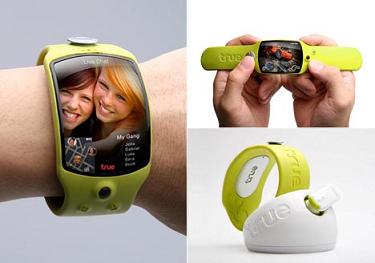The second part of this application would support teens and young adults with more severe disabilities who participate in a community-based vocational training program. The application would provide a means of giving the students feedback during on-site work activities as well as in work adjustment simulation activities at school.
I abandoned the idea early on, due to frustrating BlueTooth issues and the lack of a suitable way to secure the PDA to various types of wrists.
It is 2010 and now we have the iPhone, iPad, touch-screen netbook/slates, e-readers, 3GS, consumer-ready RFID, low-cost portable GPS devices, and in some places, ubiquitous free Wi-Fi, low-cost digital cameras, and a range of devices that have the potential to play together in some way. Below are a few examples of how far things have come.
EXAMPLES

True Wearable, by Propeller (This was a prototype introduced in 2007, I think.)



(Belkin Sports Armband for iPhone; Trueband, by Grantwood Technology; MarewareSportShell)
RIDGELINE W200
The water-resistant Ridgeline has many of the features I'd like, such as the touch screen interface, a blacklit keypad, an adjustable strap, and range of I/Os. I kind of liked the wearable scanner and imager feature. The scanner/imager can be rotated. If the imager also included a video camera, it would be a plus, since I use video quite a bit to develop video social stories for some of the students I work with who have autism spectrum disorders.
The Ridgeline W200 is too ugly and clunky for me to consider wearing! I'm sure price of the Ridgeline would be out of the question for public school employees and community mental health workers who work with young people with special needs.


(Ridgeline W200 Wearable Touch-Screen Computer)


"Everybody had them or at least seen ‘em. Slap bracelets were usually made of thin piece of aluminum wrapped in fabric. Using the same form, Chocolate Agency came up with a mini multimedia device that snaps on with a slap. The entire surface is E-Paper and possesses all its thin, high contrast, power efficient qualities. The length can be adjusted by adding magnetic snaps to the ends. Best part is there’s no recharging needed. It gets all the power it needs via kinetic energy so go ahead, go slap happy." -Yanko Design
The Nokia Morph is a concept project that integrates nanotechnology into mobile devices. I posted about the Morph last year: Last Night I Dreamt About Haptic Touch-Screen Overlays

Asus Waveface Smartphone (Video from CES 2010)
The Porcupine
This morning I devoted about 45 minutes skimming over the Proceedings for the Fourth International Conference on Tangible, Embedded, and Embodied Interaction, TEI '10, held January 25-27 in Cambridge, MA. A paper related to the Porcupine, a wearable sensing device, caught my eye:
Coming to Grips with the Objects We Grasp: Detecting Interactions with Efficient Wrist-Worn Sensors (Eugin Berlin, Jun Liu, Kristof van Laerhoven, Bernt Schield, TEI 2010)
From what I can tell, the features of the Porcupine, if embedded in a wearable iPhone-type device, would be extremely useful in a variety of fields, including special education, rehabilitation/habilitation, health care, mental health, vocational training for people with more complex disabilities, and so on.
Porcupine

Porcupine Project Documents
(The code for Porcupine is available on Sourceforge.net.)
Sixth Sense


I posted about Sixth Sense earlier in 2009:
Pattie Maes TED Talk: Sixth Sense - Mobile Wearable Interface and Gesture Interaction (for the price of a cell phone?!) Sixth sense allows you to use ANY surface for interaction, and can provide you relevant information about whatever is in front of you. This would be a great feature for people with disabilities and in the future might also function as a cognitive prosthesis.
Below is a TED Talk video of Pranav Mistry, the Ph.D student who invented Sixth Sense, discussing open-source Sixth Sense and related applications:
Below is a TED Talk video of Pranav Mistry, the Ph.D student who invented Sixth Sense, discussing open-source Sixth Sense and related applications:
So now what?
After the iPad was unveiled, several people who blog about assistive technology and augmentative communication were curious to see if the new device had the potential for use with people who have disabilities.
It does.
After the iPad was unveiled, several people who blog about assistive technology and augmentative communication were curious to see if the new device had the potential for use with people who have disabilities.
It does.
Here are a few links:
From what I understand, the iPad will work with Proloquo2Go, an alternative/ augmentative communication program for Apple's iPhone and iPod Touch. Proloquo2Go is priced at a level much lower than other PDA-based systems, and can be purchased at the iTunes App Store. It can be downloaded for use on the iPad once the iPad is available to consumers.
This is great news.
Now someone just needs to get on the convergence train and develop a flexible, mobile device that incorporates the best features of the devices and applications that currently exist!
This is great news.
Now someone just needs to get on the convergence train and develop a flexible, mobile device that incorporates the best features of the devices and applications that currently exist!
No comments:
Post a Comment